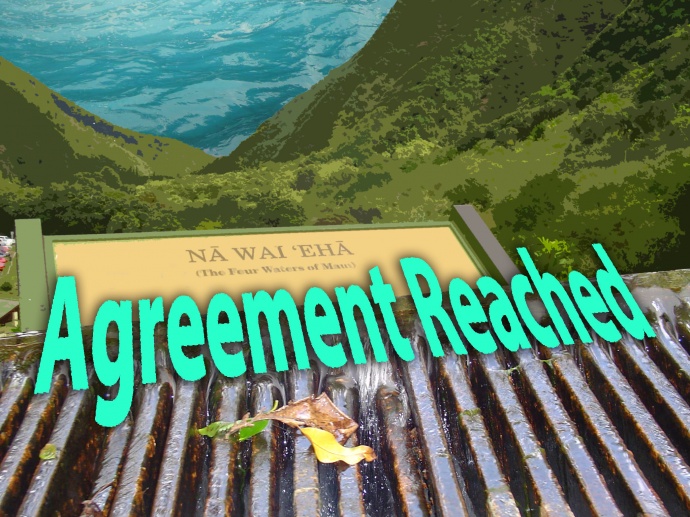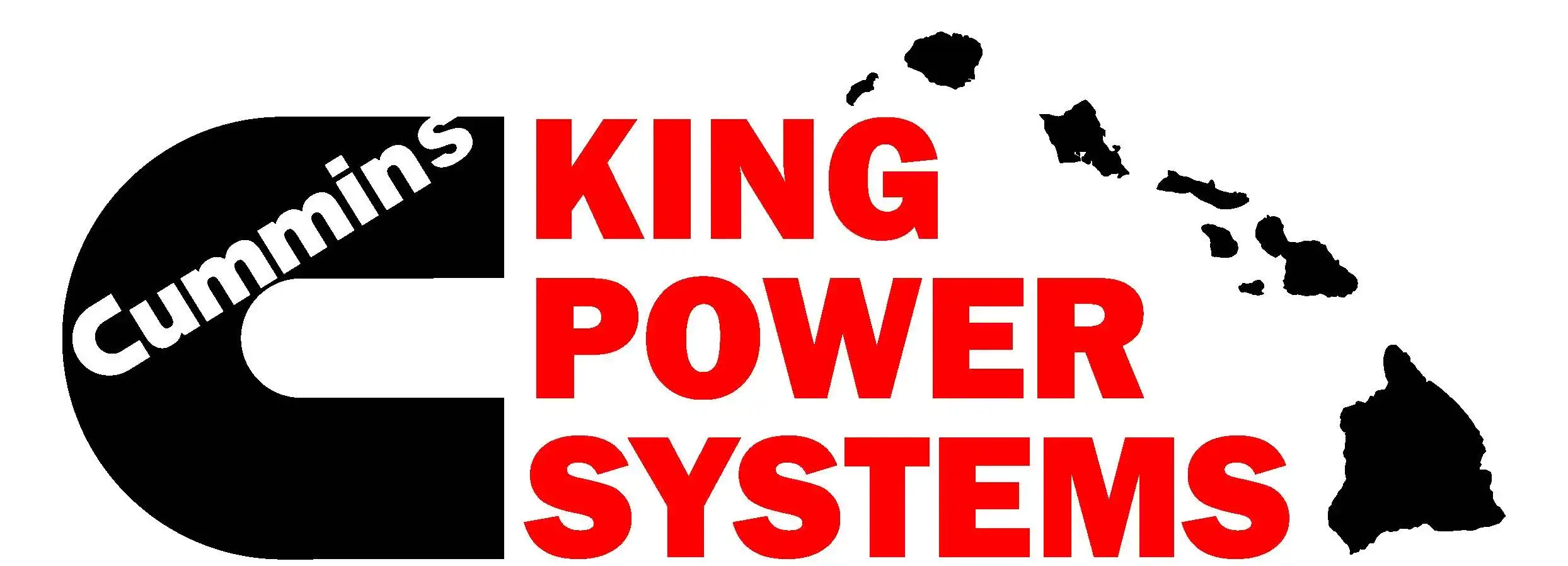Nā Wai ʻEhā Agreement Calls for More Water Restoration at ʻĪao
By Wendy Osher
More water will be returned to streams of Nā Wai ʻEhā, particularly water in ʻĪao, under an agreement reached in the Nā Wai ʻEhā contested case hearing, state officials announced today.
The latest developments come after a decade-long battle over water rights and the health of the streams, with partial restoration of water ordered and implemented in 2010.
The settlement establishes a new interim instream flow standard, or the minimum required flow, of up to 10 mgd for Wailuku (ʻĪao) Stream, and 2.9 mgd for Waikapū Stream. It also maintains the previous restorations of 10 mgd for Waiheʻe River and 2.5 mgd for Waiehu Stream.
The waters are collectively known as Nā Wai ʻEhā or “the four great waters.”
According to an announcement from the state Department of Land and Natural Resources, the parties in the case addressed six issues including the effect of instream flows on traditional and customary practices, and alternative management actions.
Parties in the case included: Hui o Nā Wai ʻEhā, the Maui Tomorrow Foundation, the Office of Hawaiian Affairs, Hawaiian Commercial and Sugar Company, Wailuku Water Company, and the County of Maui Department of Water Supply.
The agreement was reached with the assistance of mediator Robbie Alm and Hearing Officer Dr. Larry Miike. A final review and approval of the settlement was made by the state Attorney General.
“It was the Parties themselves who chose to reach this agreement. Without their collective will to work out a solution, this would not have happened,” said DLNR Chairperson William Aila Jr. in a department press release.
Governor Neil Abercrombie also commented saying, “After decades of disagreement, this is a huge step forward in the history of water on Maui. There is more to be done, but we look forward to working with all the Parties in the future. The mediator and the Water Commission helped facilitate the conversation, but it was really the people on Maui who made it possible.”
According to a post on the Hui o Nā Wai ʻEhā Facebook page, shortly following the announcement, the group stated the following:
“It has been almost 10 years to the day that we have been working towards restoring the streams of of Nā Wai ‘Ehā. The Interim Instream Flow Standards is just one hurdle that we have overcome today. Everyone needs to know that in this settlement, only three of the four streams–Waihe’e, Waiehu, and Wailuku (ʻĪao)–will be flowing mauka to makai. Although a good portion of Waikapū Stream will be restored, most if not all of that flow will continue to be diverted where the Waiheʻe Ditch intake crosses under Waikapū Stream. The Keālia Wetlands and Māʻalaea Bay will not benefit from this restoration. Also, Wailuku Water Company’s diversions need to be modified to enable mauka to makai stream flow connectivity. This is a must for our native stream life (ʻoʻopu, hīhīwai, ʻopae) to survive. As mentioned, this a positive first step forward however, there are many more issues that need to be resolved in order to truly say all four streams in Nā Wai ʻEhā are restored and flowing mauka to makai.”
“Maui Tomorrow thanks all concerned for working together to resolve this portion of a more than decade-long process. The settlement is a great first step in moving Maui’s water policy into the 21st century,” said Irene Bowie, Maui Tomorrow’s Executive Director in a press release statement from the Environmental Law Firm, Earthjustice.
Hui o Nā Wai ʻEhā Board Member John V. Duey also commented saying, “After an intense legal battle, the law is finally being respected, our native stream animals will have a chance to complete their life cycles, kalo farmers can access the water they need, and our kids won’t have to go above the Companies’ diversions to swim. That’s a significant victory in our eyes.”
Earthjustice Attorney Isaac Moriwake issued a statement saying, “There still are many other outstanding issues, including the pending permitting process in which the diverters will be required to prove their actual needs and lack of practicable alternatives to stream diversions. In the meantime, however, this restoration will get all four Nā Wai ʻEhā streams flowing and start bringing them back to life.”
The Commission’s Order, the Hearing Officer’s Recommendation, and the Parties’ Stipulation can be found on our site at the following direct LINK.
According to the document, the commission notes that, “ʻĪao Stream and Waiheʻe River have the greatest restorative potential in terms of increasing habitat for native fauna because the two streams together comprise 87.8% of the total naturally occurring habitat units for native amphidromous species within all Nā Wai ʻEhā Streams combined. Of all the streams, ʻĪao Stream has the highest restorative potential.”
The order further states the following:
- Waiheʻe River: The IIFS for Waiheʻe River at both the Waiheʻe Ditch and the Spreckels Ditch intakes shall remain at 10 mgd per the 2010 D&O
- North Waiehu Stream: The 2010 D&O established an IIFS of 1.6 mgd for North Waiehu Stream just below the point where the stream was then being diverted by WWC into the now abandoned North Waiehu Ditch. The IIFS for North Waiehu Stream shall be relocated to a lower elevation to reflect the fact that the Upper North Waiehu Diversion has been abandoned. The new IIFS location shall be just below the existing North Waiehu diversion structure located just above the Waiheʻe Ditch. The new IIFS amount will be 1.0 mgd, which is intended to reflect the approximately 0.6 mgd of seepage loss in the streambed between these two points. In connection with the relocation and the amendment of the IIFS, WWC will: a. provide water to the kuleana property that previously was provided water from the North Waiehu Ditch; b. in consultation with Commission staff modify the existing North Waiehu diversion structure located just above the Waiheʻe Ditch to facilitate the upstream and downstream passage of native stream species; and, c. continue to service the Waiehu kuleana users from the Waiheʻe Ditch.
- South Waiehu Stream: The 2010 D&O established an IIFS of 0.9 immediately below the Spreckels Ditch Diversion on South Waiehu Stream. The IIFS for South Waehu Stream below the Spreckels Ditch diversion shall be set in accordance with the Fourth Stipulation and Order of the Parties filed with the Commission on January 3, 2012, to wit: the sluice gate on HC&S’s South Waiehu diversion structure has been set to allow sufficient water to enter the diversion ditch during low stream flows to result in approximately 250,000 gpd to flow from the diversion ditch to the kuleana intake, with the remainder of the low flows being returned to the stream.
- ʻĪao Stream: The IIFS just below the diversion operated by WWC on ʻĪao Stream above the ʻĪao Waikapū and the ʻĪao-Maniania Ditches shall be 10 mgd; provided, however, that when the average daily flow measured at USGS stream-gauge station 16604500 on ʻĪao Stream is between 15 mgd and 10 mgd and has continued in that range for three consecutive days, the greater of one-third (1/3) of the stream flow or 3.9 mgd may be diverted for non-instream use until the flow returns to 15 mgd or above. When the average flow for any day falls below 10 mgd, commencing the next day and continuing until the average daily flow returns to at least 10 mgd, 3.4 mgd may be diverted for non-instream use. The intent is to provide adequate water to accommodate MDWS’s 3.2 mgd for its water treatment plant and the estimated 0.2 mgd used by kuleana users served exclusively by the ʻĪao Waikapū Ditch. This is nonetheless without prejudice to the rights ofthe Parties and the Commission to revisit allocations of diverted water in any proceeding involving a WUPA for water diverted from ʻĪao Stream. In lieu of setting an IIFS at the Spreckels Ditch diversion, a new IIFS of 5 mgd shall be established at or near the stream mouth. No water may be diverted at the Spreckels Ditch intake operated by HC&S except when the stream flow is adequate to allow the IIFS of 5 mgd at the mouth of ʻĪao Stream to be satisfied.
- Waikapū Stream: The IIFS for Waikapū Stream shall be 2.9 mgd, measured below the South Waikapū Ditch diversion (Reservoir 1 diversion) return. At the Waiheʻe Ditch diversion, the current status quo will continue, which is that water remaining in Waikapū Stream at that point is diverted into Waiheʻe Ditch except during periods of high flow, when most of the flow of Waikapū Stream passes or tops the diversion and flows toward Keālia Pond, and excess ditch flow is discharged into Waikapū Stream. The intent is that the frequency and amount of intermittent flows that pass this diversion during rainy periods will not be diminished by any change in the manner in which this diversion is currently operated.










